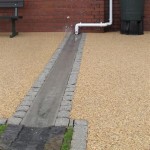How to Build an Outdoor Patio with Pavers
Constructing an outdoor patio with pavers is a rewarding project that can enhance your property's aesthetic appeal and create a functional outdoor living space. Pavers offer durability, versatility, and a timeless look, making them a popular choice for patios, walkways, and driveways. This guide will provide a comprehensive breakdown of the process, covering essential steps from planning to completion.
1. Planning and Preparation
The first step in building a paver patio is thorough planning and preparation. This crucial phase sets the foundation for a successful project. Consider the following factors:
- Design and Size: Determine the desired shape, size, and layout of the patio. Consider existing landscape features and the surrounding architecture. Sketch a plan to visualize the final design.
- Location and Access: Choose a level and accessible location for the patio. Ensure it receives appropriate sunlight and shade based on your needs. Also, make sure adequate access is available for material delivery and construction.
- Materials and Budget: Research various paver types, sizes, colors, and patterns. Determine your budget and choose materials that align with your preferences and financial constraints. Factor in the cost of gravel, sand, edging materials, and tools.
- Permits and Regulations: Check with your local building department regarding any permits or regulations that may apply to patio construction. Some areas require permits for structures exceeding a certain size or located within a specific setback from property lines.
- Site Preparation: Clear the area of vegetation, debris, and existing landscaping elements within the designated patio space. Excavate the soil to the desired depth, ensuring a level and stable foundation. The depth will vary depending on the type of pavers and soil conditions.
2. Establishing a Solid Foundation
A strong foundation is crucial for a durable and long-lasting patio. The following steps ensure a stable base for your pavers:
- Compacted Base: After excavating the area, spread and compact a layer of gravel, typically 4-6 inches thick. This layer provides drainage and stability. Use a plate compactor to achieve proper compaction for optimal strength.
- Sand Bedding: Apply a layer of sand over the compacted gravel, creating a smooth and level bed for the pavers. This layer should be about 1-2 inches thick and leveled using a screed board. The sand serves as a cushioning and leveling agent.
- Edging: Install edging materials to define the perimeter of the patio and prevent pavers from shifting. Popular edging options include plastic, metal, or concrete edging. Choose materials that complement the style of your paver selection.
- Drainage: Ensure proper drainage to prevent water accumulation. Create a slight slope away from the house or any other structures to allow water to flow away from the patio. Consider incorporating drainage channels or gravel-filled areas within the patio design to facilitate drainage.
3. Installing and Setting Pavers
With a solid foundation in place, you can proceed with installing and setting the pavers. Follow these steps for a professional-looking installation:
- Laying Pavers: Begin laying the pavers from one corner of the patio and work outwards. Ensure they are level and flush with each other. Use a rubber mallet to tap them into place and make minor adjustments as needed. Consider using a string line or a laser level to ensure accurate placement and alignment.
- Spacing: Maintain consistent gaps between pavers for proper drainage and to accommodate expansion and contraction due to temperature changes. Use spacers to ensure that the gaps are uniform throughout the patio.
- Sanding: After laying all the pavers, sweep sand into the joints to lock them in place and prevent shifting. Use a stiff brush to sweep the sand into the gaps between the pavers. Ensure the sand penetrates the joints completely.
- Compacting: Compact the sand using a plate compactor or a vibrating rod. This step further secures the pavers and provides additional stability. Compact areas in sections to ensure that the sand is evenly compacted throughout the patio.
- Cutting and Finishing: Cut pavers as needed using a wet saw or a masonry saw to fit them around corners, edges, or any obstructions. Apply sealant to the sand joints to prevent dirt and weeds from growing, enhance color, and make cleaning easier.

Diy Paver Patio For Normal People

How To Build A Diy Patio For Under 120 Outdoor Spaces

Diy Paver Patio For Normal People

How To Build A Paver Patio Young House Love

5 Steps For How To Build A Patio With Pavers And Long It Can Take Greenwave Landscape Design Services

Paver Patios Install A Diy Patio With Brick Or Stone Decks Com

How To Build A Patio In Weekend Finegardening

Diy Paver Patio And Firepit Life On Shady Lane

How To Build A Paver Patio Rogue Engineer

How To Build A Paver Patio Budget Dumpster
Related Posts








